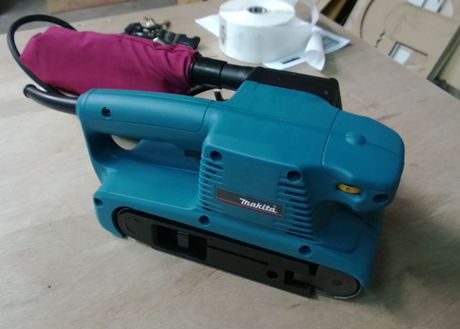Difference between revisions of "Equipment/Makita9911"
Perfectphase (Talk | contribs) |
|||
| (One intermediate revision by one user not shown) | |||
| Line 1: | Line 1: | ||
| + | {{OrangeTool}} | ||
| + | |||
[[Equipment|Equipment]] / Belt Sander | [[Equipment|Equipment]] / Belt Sander | ||
| Line 38: | Line 40: | ||
If you've never used a portable belt sander before, please watch these videos first [https://www.youtube.com/watch?v=ZoJXiLMJZak| Tips for belt sander Safety (Video)] and [https://www.youtube.com/watch?v=5gNwIL-hbuw| Belt sander tips (video)] | If you've never used a portable belt sander before, please watch these videos first [https://www.youtube.com/watch?v=ZoJXiLMJZak| Tips for belt sander Safety (Video)] and [https://www.youtube.com/watch?v=5gNwIL-hbuw| Belt sander tips (video)] | ||
| − | Please refer to the product manual for detailed instructions on how to use the belt sander. A printed copy is also kept with the | + | Please refer to the product manual for detailed instructions on how to use the belt sander. A printed copy is also kept with the sander. [[File:Makita9911usermanual.pdf| Belt sander manual]] |
Prepare your wood to be sanded by ensuring it is properly secured on the table or workbench. | Prepare your wood to be sanded by ensuring it is properly secured on the table or workbench. | ||
Latest revision as of 15:09, 3 May 2013
Class Orange equipment: Only use if you are confident doing so. Training is available if not.
(More about equipment classes)
Contents
Summary
A belt sander is a woodworking tool designed to sand down or smooth wood to prepare it for finishing. It can also be used to smooth or round edges. A belt sander is rather large and if not used properly can result in damaging your wood or causing serious injury. However, using a belt sander is a pretty simple operation.
Owners
Health and Safety
Sharp Object/material
- Power supply to be disconnected when changing belts.
- Wait for the belt to stop moving before putting the tool down.
Slips, Trips and Falls
- Waste material/offcuts to be kept clear of work area.
Fire
- Equipment will be checked for defects before each use to minimise the risk of possible electrical faults or fire.
- Carbon Dioxide extinguisher to be available for any electrical fires
Electric shock
- The equipment will be checked before each use to ensure that there are no defects in the casing, battery or cutting head.
Sight/Noise/Dust/Vibration
- P.P.E. to be worn when using the equipment.
- Regular brakes to prevent fingers becoming numb
Repetitive Action/Physical Fatigue
- Regular breaks if work is lasting more than 5 minutes in duration
Training
Instructions
If you've never used a portable belt sander before, please watch these videos first Tips for belt sander Safety (Video) and Belt sander tips (video)
Please refer to the product manual for detailed instructions on how to use the belt sander. A printed copy is also kept with the sander. File:Makita9911usermanual.pdf
Prepare your wood to be sanded by ensuring it is properly secured on the table or workbench.
Put on the necessary safety gear, such as goggles or gloves. Belt sanders can kick up a lot of sawdust, which can easily fly into your eyes. This could lead to instinctively dropping the sander, which could cause injury.
Start the motor of the belt sander while holding it away from the wood you intend to sand. Ensure it is at full speed before bringing it in contact with the wood. Start with a coarse belt, and finish up the sanding with a finer grit.
Bring the rear of the sander down to the wood, ensuring you have a firm grip on the back handle, which is used to control the sander.
Bring the rest of the sander onto the wood as smooth as possible.
Move the sander back and forth in smooth, even motions, using the front handle to guide it across the wood.
Tips & Tricks
Always move the belt sander parallel to the grain of the wood. This will ensure an even and smooth surface.
Always keep the sander moving, as leaving it running in one place on the wood can prevent an uneven surface.
Don't tip the sander on its side, as the edge of the sander can cut into the wood
Don't put any unnecessary extra pressure on the wood. The belt sander is a heavy instrument and typically uses its own weight to apply even pressure.
Maintenance
Every month inspect for damage and general wear and tear and asses state of stock blades and replace as needed.
Every six months the carbon motor brushes should be inspected for wear, and replaced as necessary.
